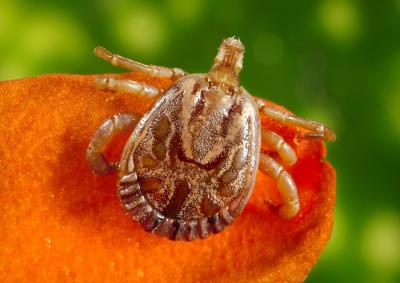
A male cayenne tick, Amblyomma cajennense, a tick species which is a North, Central, and South American carrier of Rickettsia rickettsii bacteria, which cause Rocky Mountain spotted fever.
Rocky Mountain spotted fever is a tickborne disease first recognized in 1896 in the Snake River Valley of Idaho. It was originally called “black measles” because of the look of its rash in the late stages of the illness, when the skin turns black. It was a dreaded, often fatal disease, affecting hundreds of people in Idaho. By the early 1900s, the disease could be found in Washington, Montana, California, Arizona, and New Mexico.
Tickborne diseases are becoming a serious problem in this country as people increasingly build homes in formerly uninhabited wilderness areas where ticks and their animal hosts live. Tickborne diseases can be caused by viruses, bacteria, or parasites. Most people become infected through tick bites during the spring and summer months.
Because of the work started by Dr. Ricketts in the early 1900s, NIAID Rocky Mountain Laboratories (RML) remains a thriving center for infectious disease research on tickborne diseases, such as Lyme disease and relapsing fever. RML also continues to do research on rickettsial diseases.
Related Public Health and Government Information
To learn about risk factors for Rocky Mountain spotted fever and current prevention and treatment strategies visit the Centers for Diseases Control and Prevention (CDC) Rocky Mountain spotted fever site.


